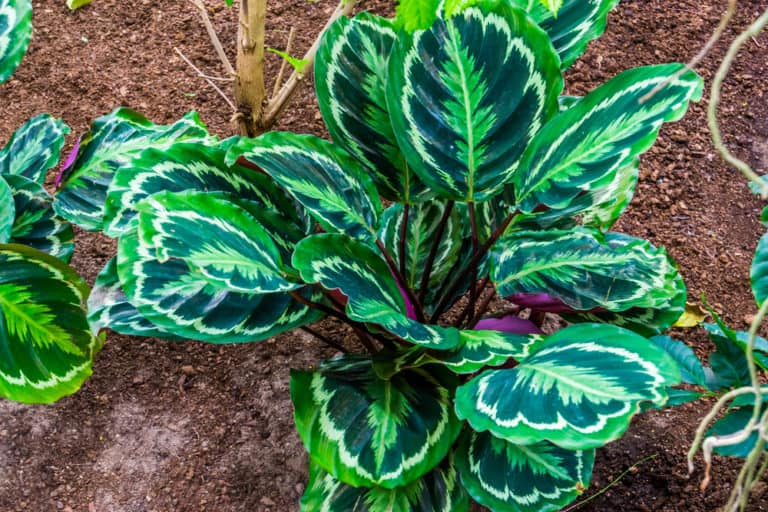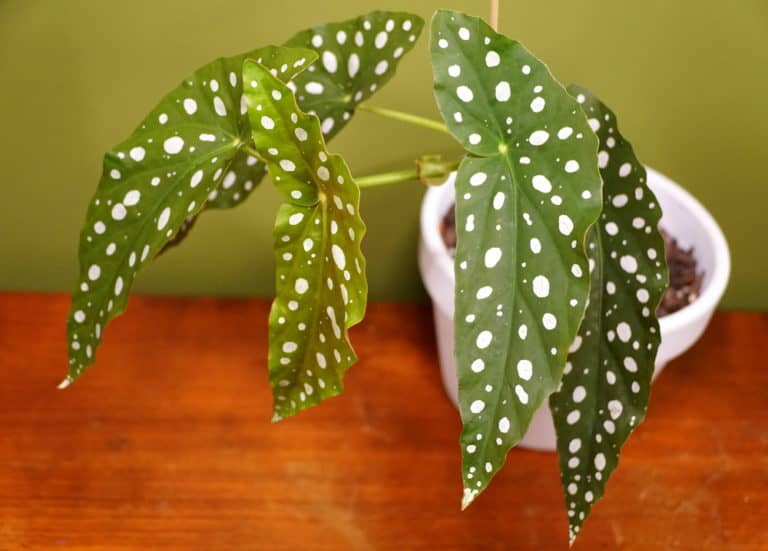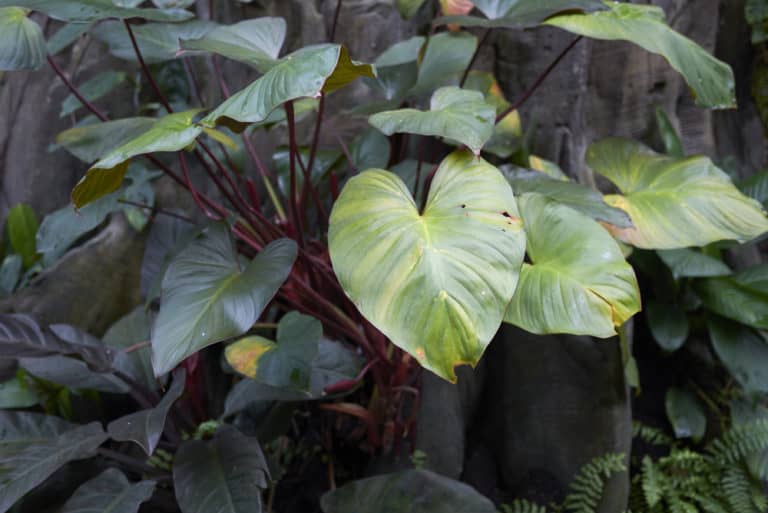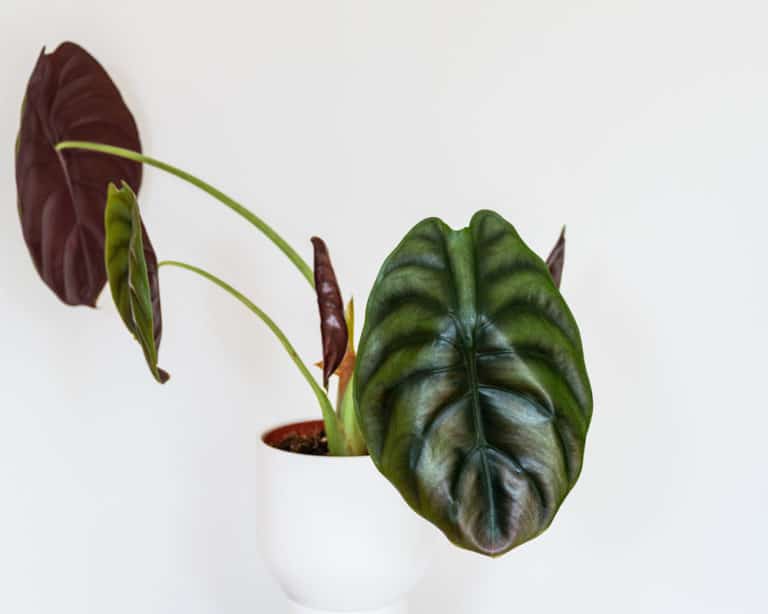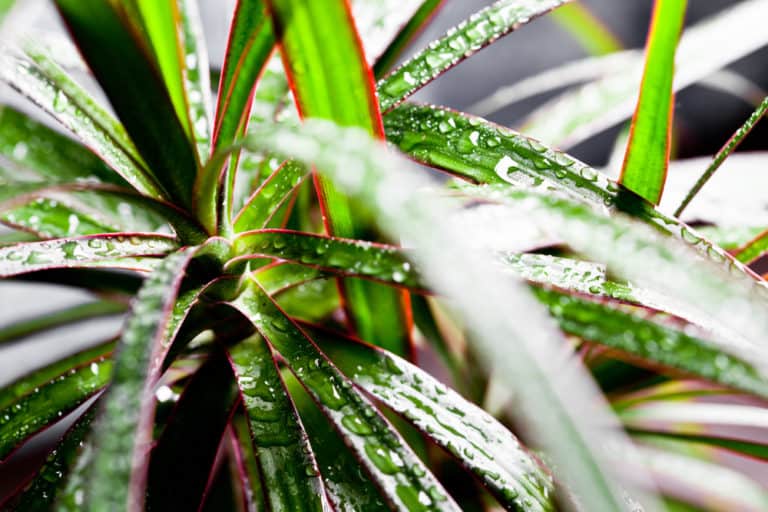Ctenanthe Lubbersiana ‘Bamburanta’ Care Guide (2024)
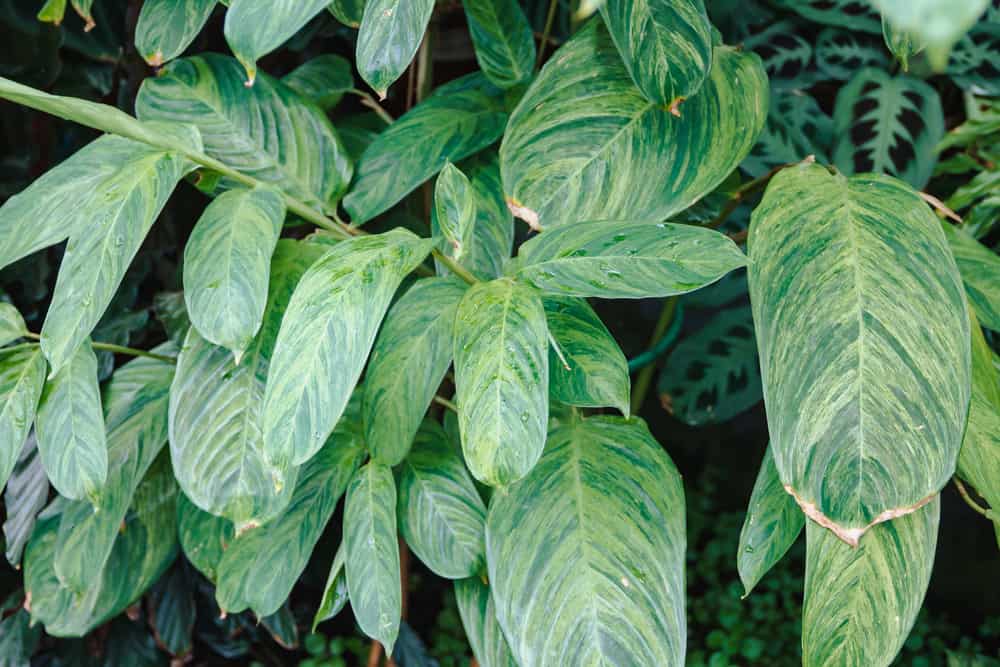
You might have not often heard of Ctenanthe lubbersiana. That’s totally understandable. This plant has been a popular staple for indoor settings during the 60s and 70s. What makes it distinct is the creamy yellow to golden highlights on its leaves.
Also known as Bamburata, this species is native to Brazil and one that’s not easy to grow.
| Scientific Name | Ctenanthe lubbersiana |
| Common Name | Bamburanta, Never-never plant |
| Light | Dappled Sunlight (Shade through upper canopy all day) |
| Watering | Water when the top 25-50% of soil is dry |
| Temperature | 60 to 80ºF (15.56 to 25ºC) |
| Hardiness Zone | 11b, 11a, 12a, 12b |
| Humidity | High humidity |
| Soil Type | Well-drained, peat-based, indoor potting soil |
| Soil pH | Acid (<6.0); Neutral (6.0-8.0) |
| Fertilizing | A general houseplant fertilizer with iron every four weeks |
| Repotting | Spring season once every 2 years |
| Pruning | Doesn’t usually need pruning, aside from the removal of dead and unsightly leaves |
| Propagation | Division of rooted offshoots or by cuttings |
| Toxicity | Non-toxic to humans and pets but individual allergic reactions have been reported |
| Mature Size | Up to 18 inches tall |
| Bloom Time | Usually late spring to early summer |
What’s Unique About Ctenanthe lubbersiana?
As a member of the Marantaceae family, Ctenanthe lubbersiana is best known for its attractive foliage. Just like the other prayer plant species, its long, oval leaves also fold up during the night.
But during the day, when they’re open, you’ll surely be caught by the beauty of its uniquely variegated foliage.
More than being an ornamental piece, this plant is also best for cleaning the air inside your home or office. It has anti-pollutant properties, which are beneficial for poorly ventilated areas. If you wish to have fresh and clean air indoors, this foliage plant is a perfect option.
Ctenanthe lubbersiana Care
There are three important things to remember when it comes to Ctenanthe lubbersiana plant care. Maintain high humidity. Provide ample amount of water. And avoid exposure to drafts and temperatures lower than 60ºF (15ºC).
To keep the plant happy, make sure that you give serious attention to bamburanta care needs.
Light
In its natural habitat, it grows under tree canopies. Hence, it’s used to receive dappled light. When taken as a houseplant, Ctenanthe lubbersiana light requirements remain the same.
The perfect spot is a South or West facing window where it receives bright, indirect light throughout the day. Avoid full sun exposure. If light gets too intense, provide a sheer curtain to serve as a barrier.
Low light conditions aren’t favorable as well. It may cause the leaves to turn pale and lose variegation. If there’s a need to supplement, provide at least 32 watts per square foot of artificial light to satisfy your bamburanta light needs.
Watering
Make sure to provide serious attention to the watering needs of your Never-never plant. Since it originates from a rainforest, it loves to thrive in wet environments. Do regular watering to keep the soil moist. But be cautious not to create a waterlogged condition.
Water bamburanta when the top surface of the soil gets dry. Normally, it’ll take 2 to 3 times a week when it’s summer. But when it’s winter, once a week watering will do.
Use rainwater or soft water in your Ctenanthe lubbersiana watering. Tap water contains chlorine and fluoride that may cause damage to the plant.
Temperature
Ctenanthe lubbersiana temperature range is ideal from 60 to 80ºF (15.56 to 25ºC). Once the temperature gets lower than the threshold, the leaves will start showing signs of damage. Remember to keep the plant warm at all times.
Indoor setups provide an ideal temperature for bamburanta. Just avoid placing it in spots that produce cold or hot drafts. That includes windows, doors, air conditioners, and room heaters.
If planted outdoors, we recommend bringing your plant inside your homes when the winter season comes. The temperature tolerance of Ctenanthe is limited. So, it’s important to consider its hardiness in your area.
Humidity
As a humid-loving species, Ctenanthe would require a humidity level of 60% or more. We mentioned earlier that this plant is a rainforest dweller. Naturally, it’ll crave moisture.
In most cases, a moderate humidity level is enough to keep Ctenanthe alive. But in order to flourish, there’s a need for regular misting or the use of a humidifier and pebble trays.
It also helps to strategically position your plant in a highly humid spot such as the kitchen. Those tips would help achieve the ideal humidity for bamburanta.
If you fail to achieve Ctenanthe lubbersiana humidity requirements, you’ll notice browning on the edges of its leaves.
Soil
The Ctenanthe lubbersiana soil must be moist and well-draining. Such characteristics are important to keep the roots well-hydrated but not drowned with excess water. To achieve this, you can combine coco peat and perlite in a 3:1 ratio.
The ideal ph level for bamburanta soil is 6.1 to 7.5. This range would allow the Ctenanthe to utilize the nutrients in the soil. Use a digital pH meter to be sure.
Ensure proper soil mix drainage. Test first by pouring water on the medium. See if water drains immediately after. Remember to also sterilize the soil for bamburanta before potting.
Fertilizer
Provide Ctenanthe lubbersiana fertilizer during the growing seasons, spring and summer. Monthly application of diluted, balanced fertilizer will be enough to support lush growth. No need to add fertilizer in the winter months. They’re naturally dormant during these times.
You may use a general houseplant fertilizer for bamburanta. Just dilute it at half strength and pour it directly into the soil. Apply this at 4 weeks intervals during watering or as needed.
To avoid overfertilizing, follow only the recommended fertilizer ratio. It also helps to add aged compost to the soil mix during potting for the slow release of nutrients.
Potting & Repotting
The preferred pot size for potting is a 10 cm container that has enough drainage holes. Drill additional holes if you think they’re not enough. Terracotta or plastic pot are both acceptable for potting.
Repotting bamburanta will have to take place every year or two. Remove from its pot and shake off depleted soil. Trim the aged roots, repot them in a bigger pot, and water it well. As the roots gain access to enough air, water, and nutrients, the plant regenerates and grows fuller.
The time for Ctenanthe lubbersiana repotting is also the perfect opportunity to divide the plant and remove offsets for propagation.
Pruning
Nothing much is required when it comes to Ctenanthe lubbersiana pruning. It won’t require regular pruning other than the removal of dead, aged, or diseased leaves. Do this as part of your maintenance routine.
Using a sharp pruning shear, trim the old leaves at the base of the stem. You may also detach the offsets to retain the mother plant and control the plant’s size. Doing so will help redirect the energy into younger leaves.
To avoid bacterial or fungal infection, use disinfected pruning shears or scissors in cutting bamburanta. Always make clean incisions so the wounds won’t get infected.
Propagation
The best way to propagate bamburanta is through division or stem cuttings. In division, you detach the grown offset from the main plant. Pot it separately and you now have a baby bamburanta growing.
If using stem cuttings, choose a mature and healthy stem. Make sure it has lush leaves. Cut below the nodes and wash it after. You have the option to plant it directly in a growing medium or allow it to develop roots first while in water. It depends on your preference.
Generally, Ctenanthe lubbersiana propagation is quite an easy job. The success rate is always high.
Common Problems of Ctenanthe lubbersiana
Majority of the Ctenanthe lubbersiana problems that you’ll encounter have something to do with stress. It’s either caused by incorrect growing conditions or the occurrence of pests and diseases. These three factors could have minimal or severe damage.
The yellowing of the leaves is caused by water problems. The appearance of dark spots can be a sign of bacterial or fungal infection. Extreme light or temperature can cause curling of the leaves.
Proper diagnosis of the problems with bamburanta is an important step. Make sure to investigate the causes before devising a solution. Carefully adjust the growing conditions when necessary.
Pests
Spider mites and mealy bugs are common pests in Ctenanthe. They love taking residence on the underside of the leaves. They suck the plant’s sap leaving tiny lesions on its surface. Severe damage can lead to the yellowing of the foliage.
To detect these organisms, you have to closely check the leaf surface. Mealy bugs have a powdery white appearance while the spider mites will create tiny spider webs. Once you notice their presence on your bamburanta, take immediate action to get rid of them.
Use neem oil, soap solution, alcohol, or herbal water spray to kill Ctenanthe lubbersiana pests.
Diseases
Diseases such as root rot, leaf spot disease, botrytis, rust, powdery mildew, and southern blight may occur. Their occurrence is mostly triggered when there’s a soggy soil condition. When left unattended, such diseases may end the life of your bamburanta.
The plant will show signs of infection such as root and stem rot, leaf lesions, yellowing or browning, and lack of vigor. It’s crucial to pay attention to the early signs of Ctenanthe lubbersiana diseases.
Treat them with fungicides or bactericides, depending on the diagnosis. If unsure, ask a plant health expert for help. To avoid future problems, always use disinfected garden tools and sterilized soil.
Growing Problems
For a newbie, growing Ctenanthe lubbersiana won’t be an easy feat. This species will require a moderate to a difficult level of care and maintenance. Growing problems such as curling, yellowing, or browning of leaf edges may arise when the growing conditions aren’t ideal.
If your plant is taking so much time to grow and lacks vibrancy and vigor, it may be experiencing problems underneath. Diagnosing a sick plant isn’t easy but you can always compare its growth to other Ctenanthe plants.
To address these problems, adjust the growing conditions so they will become favorable to the growth and development of your Ctenanthe lubbersiana plant.
Toxicity of Ctenanthe lubbersiana
The bamburanta species is listed as non-toxic by the APSCA. The plant doesn’t contain any form of toxic properties and is generally safe to handle. You can plant it at home without worrying that it’s toxic to your pets and children.
Although toxicity is off the list, some folks have reported mild allergic reactions.
For Humans
If you’re health-conscious, acquiring Ctenanthe lubbersiana is a good decision. Since the plant parts are all safe, you wouldn’t have to worry about potential harm and damage to humans. However, you must remember that this plant isn’t edible. So, please don’t consume any of its parts.
If you have children around, warn them not to eat the leaves. No matter how fancy they look on the outside, they may not have a palatable taste. It may even cause irritation or allergic reactions to those who have sensitive skin. So, it’s better to be extra careful when handling your Ctenanthe plant.
For Pets
Pets are also safe with your Ctenanthe. Thankfully, you can plant them at home even when you have dogs and cats around. Being non-toxic, it won’t be a problem even if they accidentally ingest the leaves or the stems. Your pets will live.
Nevertheless, it can be mildly poisonous to some pets. Potential irritation may occur if there is so much amount of plant parts eaten. So, if you’re pets are quite sensitive, make sure to watch over them. Doing so will prevent further trouble.
We know some pets can be extra naughty. We recommend keeping them away not only from Ctenanthe but other plants as well.
Ctenanthe lubbersiana Appearance
Now, we get to the exciting part, describing the Ctenanthe lubbersiana appearance. As an evergreen shrub, this plant is always showing generous foliage. You will observe many similar traits with other species of prayer plants. The most prominent distinction would be the presence of golden venations splashed over the leaf surface.
Foliage
Just look at the stunning foliage of Ctenanthe lubbersiana and you’ll surely fall in love. The patterned texture and color combination creates a stunning look. It will become a beautiful addition to a bare space.
Each leaf follows an oval shape and has a deep green color. Golden venations are also present along the surface breaking the green hue. Such contrast of colors makes the foliage beautiful and worthy of attention.
Unhealthy plants will show signs of yellowing or browning of leaf edges. Hence, it’s very important to take good care of your plant so the leaves will remain pretty.
Flowering
It’s rare for you to see the appearance of bamburanta flower. If it’s tended to as an indoor plant, the chances of flowering are very slim. And even when it flowers, they remain almost insignificant due to their small size.
Blooming takes place during the summer seasons. This time, tiny, spike-shaped flowers develop. The colors range from white to pale yellow. Since they mostly rest beneath the foliage, they mostly go unnoticed. Although, these flowers can last for a few weeks.
Proper growing conditions are required to initiate Ctenanthe lubbersiana flowering. The temperatures must be around 18 to 25℃ (64 to 77oF).
Size and Growth
As a typical shrub plant, Ctenanthe doesn’t grow that big. The typical size of Ctenanthe lubbersiana may reach up to 18 inches tall but it can spread enormously due to offset production. Horizontal growth may reach up to 8 feet wide.
This plant has a fast growth rate producing 5 to 6 new leaves per year. With added fertilizer, the foliage will become lush. Pruning and trimming will help control the size. Annual repotting will help regenerate growth.
Plants that do not receive enough light will tend to grow leggy and sloppy. So, make sure it receives enough light.
Ctenanthe lubbersiana Fragrance
Some plant species produce fragrant scents making them more attractive. Unfortunately, Ctenanthe isn’t one of them. It has no special scent to brag about, no distinct fragrance to remember.
This can be good news to those who are sensitive to a strong smell. Ctenanthe lubbersiana fragrance isn’t something you should be worried about. However, there are also some species of prayer-plants that have a distinct rosemary smell. You may want to explore them too.
Despite having no fragrance, Ctenanthe lubbersiana will remain a beauty. Thanks to its stunning, patterned foliage. The lack of fragrance isn’t much of an issue.
Suggested Uses for Ctenanthe lubbersiana
There are various ways to use Ctenanthe lubbersiana as an ornamental piece. You can plant it in pots and place it indoors to improve your home interior. Place it in your bathroom or kitchen.
It will surely create a fresh-looking tropical vibe.
You may also plant it outdoors as ground cover or along the sidewalks or patio. They will add a splash of color to your garden. A perfect treat for anyone passing by.
Aside from aesthetic purposes, Ctenanthe also offers other benefits such as purification of the air, reduction of stress and fatigue, and boosting mood and creativity. This plant has a therapeutic effect.
Ctenanthe lubbersiana Varieties
There are three popular varieties of Ctenanthe lubbersiana. The various types of bamburanta have their own distinct features to brag about. Nevertheless, they have similarities in terms of appearance.
A product of tedious breeding, we now have different Ctenanthe lubbersiana varieties to enjoy and add to our collection. It’s important to get familiarized with their appearance and growing requirements. Doing so will help us correctly identify varieties when we go shopping for new plants.
The original Ctenanthe lubbersiana reaches a height of 18 inches and has oval leaves with a pattern of golden yellow. Now, let’s see what the other varieties look like.
Ctenanthe lubbersiana ‘Golden Mosaic’
The Golden Mosaic has elliptical leaves that grow from bamboo-like stems. The word mosaic pertains to the golden pattern that accentuates the leaves. It creates highlights on the green foliage.
Ctenanthe lubbersiana ‘Variegata’
Another variety is known as Variegata due to the presence of thin variegations on the leaves. Compared to other varieties, the golden pattern is visibly finer. It does well in pots.
Ctenanthe lubbersiana ‘Brazilian Snow’
The Brazilian Snow is also splashed with a cream color variegation. The patterns look like they’re hand-painted. The leaves have a paper-thin texture and are attached to their delicate stems.
FAQ
What is Ctenanthe lubbersiana?
Ctenanthe lubbersiana is a member of the Prayer Plant family. It’s an evergreen perennial shrub that is used as an ornamental plant because of its attractive foliage.
How to identify Ctenanthe lubbersiana?
This plant has oval-shaped leaves that grow straight up and fold during the night. You’ll also find creamy yellow to golden highlights on the leaf surface.
How to care for Ctenanthe lubbersiana?
Growing Ctenanthe lubbersiana isn’t that hard. Just provide bright, indirect light, regular watering, and high humidity. Your Ctenanthe will surely be happy with these growing conditions.
How to grow Ctenanthe lubbersiana indoors?
Keep the plant in a warm area with lots of indirect light and water. The temperature must be between 60 to 80ºF (15.56 to 25ºC).
How to grow Ctenanthe lubbersiana outdoors?
Place it in a shaded location where it receives dappled light. When the temperature gets below 60ºF (15ºC), move it indoors to avoid frost damage.
How fast does Ctenanthe lubbersiana grow?
Ctenanthe lubbersiana plants grow really fast. They also produce many offsets. You even have to repot every year at least to accomodate its growing size.
How tall does Ctenanthe lubbersiana grow?
This evergreen perennial can reach a height of 18 inches when mature. Horizontal growth can reach up to 7 feet if given the right growing conditions.
How to make Ctenanthe lubbersiana grow faster?
Repot consistently in a larger container to give more room for growth. Feed with a low dose of balanced fertilizer every month during the spring and summer.
How to stake Ctenanthe lubbersiana?
You can stake your Ctenanthe if it has a leggy growth. Place a stake in the pot and tie the stems to hold them straight up.
How to pot Ctenanthe lubbersiana?
Pot or re-pot the plant in a bigger container every year or two. Replace the growing medium with fresh soil. Prune the roots, too.
How to revive Ctenanthe lubbersiana?
Know the root cause of the problem first. Adjust the growing conditions accordingly depending on what form of stress is causing trouble to your plant.
Why is my Ctenanthe lubbersiana dying?
It could be due to watering problems, low humidity, lack of light, nutrient deficiency, or pests and diseases. Each cause has its own symptoms to show.
Why is my Ctenanthe lubbersiana drooping?
A number of stressors may cause the Ctenanthe lubbersina’s leaves to droop. It could be due to excess light and heat, low humidity, underwatering or overwatering.
How cold can Ctenanthe lubbersiana tolerate?
The plant can tolerate a temperature as low as 13°C. Once the temperature drops lower, you have to provide protection to your Ctenanthe to prevent damage.
How to get rid of pests on Ctenanthe lubbersiana?
Spray with horticultural oils or soap solutions. Alternatively, you may wipe it off with cotton dipped in alchol. Trim heavily infested leaves to prevent spread.
Is Ctenanthe lubbersiana toxic to cats?
Ctenanthe lubbersia won’t be a threat to your cats, provided that they won’t eat the plant. The plant is non-toxic but some discomfort may happen.
Is Ctenanthe lubbersiana toxic to dogs?
Dogs are generally safe with Ctenanthe lubbersiana around. The plant is non-toxic. However, we don’t recommend having it close to your pets to prevent ingestion.
Is Ctenanthe lubbersiana toxic to children?
Although non-toxic, this plant could be mildly poisonous when ingested. So, it’s best to keep it away from your children. Warm them not to eat any portion of Ctenanthe.
Is Ctenanthe lubbersiana toxic to humans?
Ctenanthe lubbersiana is a non-toxic species. This makes this plant a really good candidate for indoor keeping. Some people reported allergic reactions but are just minor.
Does Ctenanthe lubbersiana have a scent?
There’s no report about Ctenanthe lubbersiana having a remarkable scent. So, there’s nothing much to expect about it.

